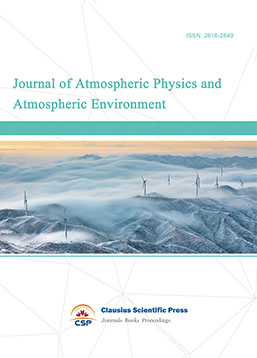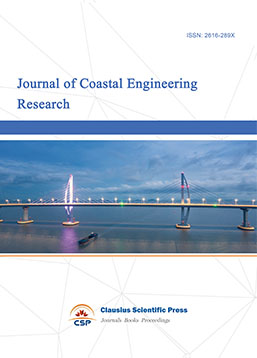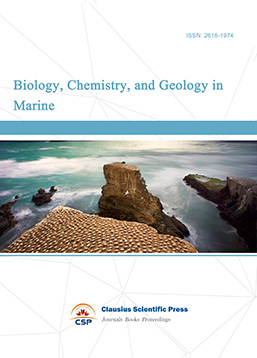Application of Signal Molecule Enhanced ANAMMOX Process in Low Temperature Ammonia Nitrogen Wastewater Treatment
DOI: 10.23977/erej.2020.040111 | Downloads: 17 | Views: 2280
Author(s)
Peng Zhou 1, Shuo Zhang 1, Jun Li 1
Affiliation(s)
1 Shenyang Jianzhu University, Hunnan East Road, Hunnan New District, Shenyang, Liaoning, China
Corresponding Author
Jun LiABSTRACT
As a new denitrification process, anammox has received extensive attention in the treatment of high ammonia nitrogen wastewater. At low temperature, ANAMMOX bacteria grew slowly and could not stay in the reactor. The reactor performance was poor. As a result, the process is greatly limited in engineering application. Appropriate addition of signal molecules can enhance the activity of ANAMMOX bacteria. The effect of the signal molecule 3-oxo-c8-hsl on the denitrification performance of anammox reactor running continuously at low temperature (15 ℃) was studied experimentally. Two parallel UASB reactors were used, one with 0.67ng/L of 3-oxo-c8-hsl signal molecule (R2) and the other without the addition of signal molecule as blank control (R1). During operation, R2 improved the maximum nitrogen removal rate by 25% compared with R1, and showed better load shock resistance. The batch experiment (SAA) showed that 3-oxo-c8-hsl could significantly improve the activity of anaerobic ammonia-oxidizing bacteria. In addition, 3-oxo-c8-hsl can maintain pH and REDOX potential (ORP) within the appropriate range, providing a stable environment for bacterial growth and reactor operation. The polysaccharides, proteins and total extracellular polymers (EPS) in the reactor increased by 5.4%, 35.2% and 29.7%, respectively, over the original sludge. Particle size and scanning electron microscope (SEM) showed that the sludge particles were compact and particle size was smaller. The addition of signal molecules enhances the reaction performance of ANAMMOX at low temperature, which can promote the application of ANAMMOX process in sewage plants in cold areas.
KEYWORDS
Anammox, N-removal, signal molecule, low temperature, wastewater treatmentCITE THIS PAPER
Peng Zhou, Shuo Zhang, Jun Li, Application of Signal Molecule Enhanced ANAMMOX Process in Low Temperature Ammonia Nitrogen Wastewater Treatment. Environment, Resource and Ecology Journal (2020) 4: 70-80. DOI: http://dx.doi.org/10.23977/erej.2020.040111
REFERENCES
[1] Strous M, Heijnen J J, Kuenen J G, et al. (1998) The sequencing batch reactor as a powerful tool for the study of slowly growing anaerobic ammonium-oxidizing microorganisms. Applied Microbiology and Biotechnology, 50, 589-596.
[2] Strous M, Fuerst J A, Kramer E H M, et al. (1999) Missing lithotroph identified as new Planctomycete. Nature, 400, 446-449.
[3] Volcke E I P, van Hulle S W H, Donckels B M R, et al. (2005) Coupling the SHARON process with Anammox: model -based scenario analysis with focus on operating costs. Water Science and Technology, 52(4), 107-115.
[4] Furukawa K, Inatomi Y, Qiao S, et al. (2009) Innovative treatment system for digester liquor using anammox process. Bioresource Technology, 100, 5437-5443.
[5] Shen L D, Hu A H, Jin R C, et al. (2012) Enrichment of anammox bacteria from three sludge sources for the startup of monosodium glutamate industrial wastewater treatment system. Journal of Hazardous Materials, 199/200, 193-199.
[6] Kartal B, Kuenen J G, van Loosdrecht M C. (2010) Sewage treat-ment with anammox. Science, 328(5979), 702 -703.
[7] Liu S T, Yang F L, Xue Y, et al. (2008) Evaluation of oxygen adaptation and identification of functional bacteria composition for anammox consortium in non - woven biological rotating contactor. Bioresource Technology, 99, 8273-8279.
[8] vander Star W R L, Abma W R, Blommers D, et al. (2007) Startup of reactors for anoxic ammonium oxidation: experiences from the first full -scale anammox reactor in Rotterdam.Water Research, 41(18), 4149-4163.
[9] Tsushima I, Ogasawara Y, Kindaichi T, et al. (2007) Development of high -rate anaerobic ammonium -oxidizing (anammox) biofilm reactor. Water Research, 41, 1623-1634.
[10] Tang C J, Zheng P, Wang C H, et al. (2011) Performance of high-loaded ANAMMOX UASB reactors containing granular sludge. Water Research, 45, 135-144.
[11] Strous M, Kuenen J G, Jetten M S M. (1999) Key physiology of anaerobic ammonium oxidation. Applied Microbiology and Biotechnology, 65, 3248-3250.
[12] Liu S T, Yang F L, Meng F G, et al. (2008) Enhanced anammox consortium activity for nitrogen removal impacts of static magnetic field. Journal of Biotechnology, 138, 96-102.
[13] Liu S T, Yang F L. (2009) The Enhancement by Electrical/Magnetic Field and Multispecies Coupling of Anammox Technology for Autotrophic Nitrogen Removal. School of Environ - mental Science and Technology, Dalian University of Techno- logy, China.
[14] Chen J W, Ji Q X, Zheng P, et al. (2010) Floatation and control of granular sludge in high-rate anammox reactor . Water Research, 44, 3321-3328.
[15] Chen H, Ma C, Yang G F, et al. (2014) Floatation of flocculent and granular sludge in a high-loaded anammox reactor . Bioresource Technology, 169, 409-415.
[16] GAO M J, WANG S Y, PENG Y Z, et al. (2016) Influence of pulsed flow fluctuation on UASB reactor of anaerobic ammonia oxidation. China Environmental Science, 36(8), 2347- 2354.
[17] Lu H F, Zheng P, Ji Q X, et al. (2012) The structure, density and settlability of anammox granular sludge in high-rate reactors. Bioresource Technology, 123, 312-317.
[18] Lu H F, Ji Q X, Ding S, et al. (2013) The morphological and settling properties of ANAMMOX granular sludge in high-rate reactors. Bioresource Technology, 143, 592-597.
[19] APHA, Standard Methods for the Examination of Water andWastewater.
[20] Morgan J.W., Forster C.F., Evison L. (1990) A comparative study of the nature of biopolymers extracted from anaerobic and activated sludges, Water Res., 24, 743-750.
[21] Tang X, Liu S T, Zhang Z T, et al. (2015) Identification of the release and effects of AHLs in anammox culture for bacteria communication. Chemical Engineering Journal, 273, 184-191.
[22] ZHANG J, ZHANG L H, JIANG D D, et al. (2018) The effects of signal molecules on the characteristics of ANAMMOX granules in high-loaded UASB reactors. China Environmental Science, 38(02), 532-541.
[23] Jetten M S M, Strous M, van de Pas Schoonen K T, et al. (1999) The anaerobic oxidation of ammonium. FEMS Microbio-logy Reviews, 22, 421-437.
| Downloads: | 5911 |
|---|---|
| Visits: | 434413 |
Sponsors, Associates, and Links
-
International Journal of Geological Resources and Geological Engineering

-
Big Geospatial Data and Data Science

-
Solid Earth and Space Physics

-
Environment and Climate Protection

-
Journal of Cartography and Geographic Information Systems

-
Offshore and Polar Engineering

-
Physical and Human Geography

-
Journal of Atmospheric Physics and Atmospheric Environment

-
Trends in Meteorology

-
Journal of Coastal Engineering Research

-
Focus on Plant Protection

-
Toxicology and Health of Environment

-
Geoscience and Remote Sensing

-
Advances in Physical Oceanography

-
Biology, Chemistry, and Geology in Marine

-
Water-Soil, Biological Environment and Energy

-
Geodesy and Geophysics

-
Journal of Structural and Quaternary Geology

-
Journal of Sedimentary Geology

-
International Journal of Polar Social Research and Review


 Download as PDF
Download as PDF